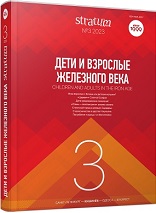Наборы костяных пластин с орнаментом «плексис» из раннекочевнических погребений III в. до н. э. на Южном Урале
Sets of Bone Plates with “Plexys” Ornaments from Early Nomad Burials of the 3rd Century BC in the Southern Urals
Author(s): Vitaliy K. FedorovSubject(s): History, Archaeology
Published by: Издательский дом Stratum, Университет «Высшая антропологическая школа»
Keywords: early nomads; Southern Cis-Urals; ornamented bone plates; casket; braided ornaments (plexys); Scythians of the Northern Black Sea region; Southern Aral Sea region; Chirikrabat Culture
Summary/Abstract: Sets of bone plates covered with braided ornaments (plexys) which were found in Bishungarovo and Zhaiyik-1 Burial Mounds in Southern Sub Urals belong to Greek-type caskets. Similar caskets were often found in Scythian burials of the Northern Black Sea region. But here the “plexys” ornaments are more widely spread than anywhere else in the early nomadic environment — in the decoration of weapons, vessels made of precious metals, on bone combs and details of spindles. In the décor of a Greek-made casket, a similar ornament was found only once — in the Chirikrabat Culture Balandi-1 in the lower reaches of the Syr Darya. Probably similar caskets came here from the state of Seleucids or Greco-Bactria in the end of the 4th—3rd century BC. Nomads of the Southern Sub Urals spent winters in the oases of the lower Syr Darya and took a few of such caskets north in the area of their summer nomadic camps where they were buried in their burials.
Journal: Stratum plus. Археология и культурная антропология
- Issue Year: 2023
- Issue No: 3
- Page Range: 133-150
- Page Count: 18
- Language: Russian
- Content File-PDF

